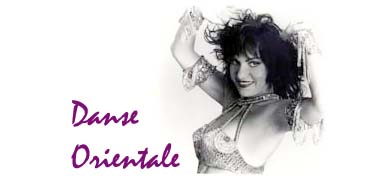 |
The following excerpts are from: Dance Scope 76/77.
"Dances of the Muslim Peoples", By Lois Ibsen Al Faruqi.Although there has been considerable literary production on dance as a religious practice, there is amazingly little information available discussing dance as an aesthetic expression or entertainment. Reports by Western travelers to Middle Eastern countries have occasionally included short descriptions of a particular dance or dancer; but, even among non-Western writers, systematic discussions of the dance are singularly rare.
Danse Orientale has been known over a long period of time in history. This dance is usually labeled derogatorily in the West as the "belly dance" or "danse du ventre." In the East such names are never used. They would be considered indecent and offensive. Instead, the dance is known as "Oriental Dance" (raqs sharqi) in Arabic. A dance of this kind was known in the Mediterranean areas as early as the Roman Empire, and it has been described by various writers in the intervening centuries. The dance has no fixed choreography, no fixed sequence of steps or floor patterns, and no predetermined time length. It is an improvised combination of movements which are repeated and varied according to the improvisatory skill and technique of the dancer.
As a professional dance, raqs sharqi is most often a solo performed by a woman in the family or community festive gathering. There are recognizable individualized movements which recur wherever this dance is done. These include head moving in a straight line from shoulder to shoulder, undulating movements of the hands and arms, shoulder shaking or jerks, trembling or horizontal movement of the breasts or the chest, trembling or flexing of the abdominal muscles, shaking or jerks with the hips, rolls by one or both hips, swirling turns, backbends, with or without shoulder or breast shaking, manipulation of flowing scarf or handkerchief, tapping of tiny metal cymbals worn on the thumb and middle finger of both hands. These movements require strict and individualized control over the muscles of the whole body.
Clothes for the raqs sharqi vary greatly depending on the occasion. When done for a cabaret audience, the female soloist sometimes wears an abbreviated bikini-type outfit augmented with sheer veils, skirt or harem trousers. More common however is the baladi (village) dress. This is a straight, long-sleeved full-length Arabian dress decorated with heavy embroidery. The dancer adds a hip sash to emphasize the movements of that portion of the body.
Not only the costume of the soloist varies for these dances when done in different situations, the movements are also altered to emphasize different qualities. The cabaret performer, for example, will make a display of sex and sensuality. On the other hand, when performed in family groups to celebrate circumcisions, weddings, harvest or national holidays, the soloist will instead stress its abstract, non-descriptive rhythmic intricacies.
In the United States the raqs sharqi has been known since a promoter by the name of Sol Bloom brought the first "Oriental dancer" to the Chicago World's Fair of 1893. The people who visited the show were fascinated. Some, however, shocked by the scantily clad dancer and her sensuously exciting number, protested against its alleged damage to morals. By 1903, the fad of "Oriental dancing" among native-born Americans seemed to be over, only to be revived in recent years with the rebirth of interest in ethnic dance and ethnic arts.
Home | Danse Orientale | Classes | Ensemble | Performances | Gallery